Fall 2018 Design Projects
Project List
- Swarm Robot Boat
- Enrichment Launching Mechanism "Cheetapult"
- UT Greywater System for Parks Tower
- Adaptive Tricycle
- Modification and User Testing of a Hand Operated Tricycle
- Nitinol Actuated Prosthetic Hand
- T-Shirt Gatling Gun
- Rocket RC Blimp for UT Athletics
- FCA Dundee Engine Plant Process Improvement
- Snow Adhesion Testing
- Low-cost 3D Printer Benchmarking and Upgrade
- Processing and Characterization of Medical Cements
- Toledo Transducer Manufacturing Anomaly Analysis
- High-Precision Adjustable Secondary Mirror Mechanism
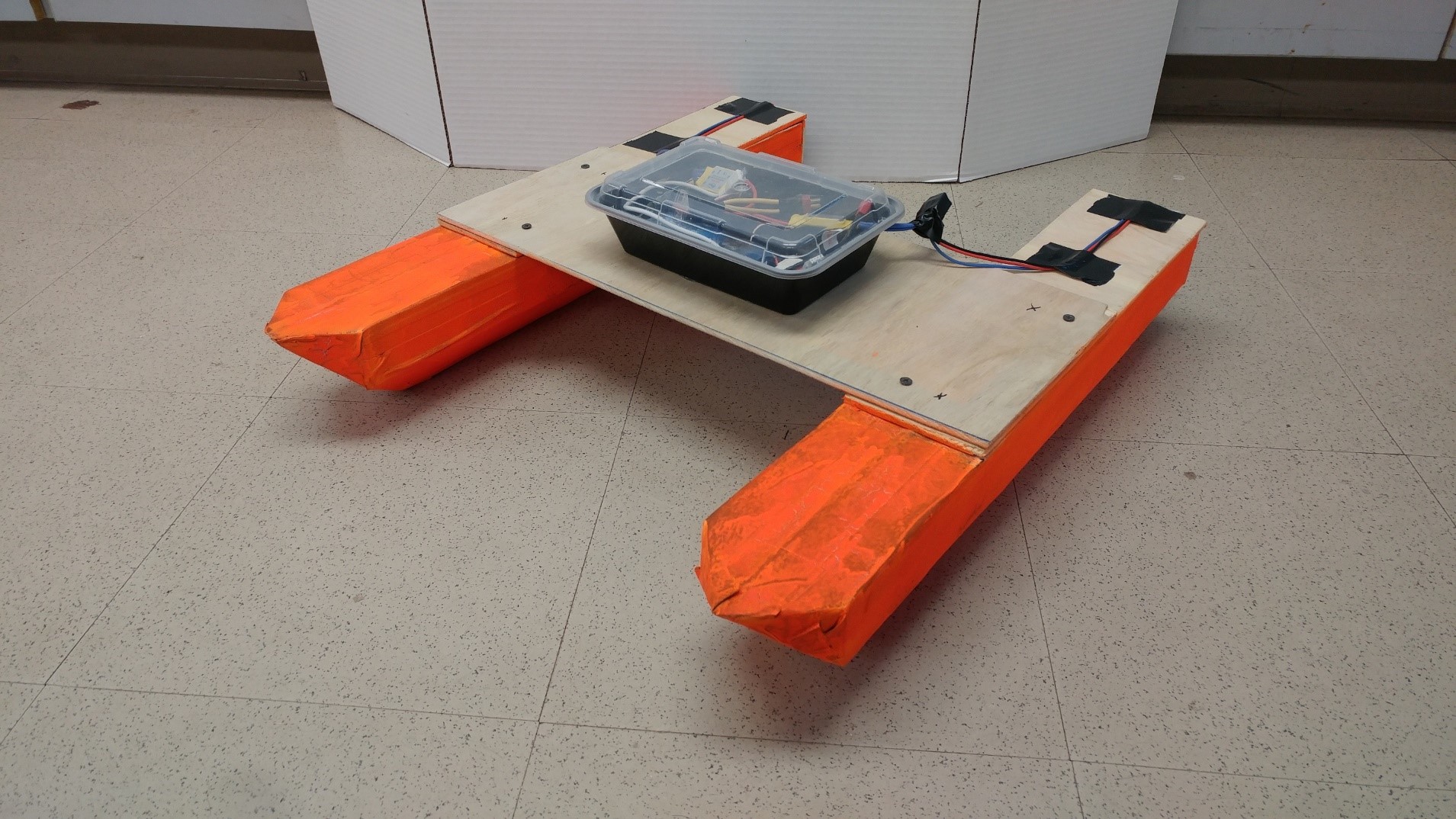 This project entails designing and manufacturing swarm robot boats. Using GPS and
an onboard computer, the robots could communicate and work together on a variety of
different tasks. The swarm boats have previously been used to collect algae from the
surface of a pond, by dragging around nets behind the boats. Utilizing onboard GPS,
the robots have the potential to avoid collisions and efficiently cover a large area
of water.
This project entails designing and manufacturing swarm robot boats. Using GPS and
an onboard computer, the robots could communicate and work together on a variety of
different tasks. The swarm boats have previously been used to collect algae from the
surface of a pond, by dragging around nets behind the boats. Utilizing onboard GPS,
the robots have the potential to avoid collisions and efficiently cover a large area
of water.
There are even more applications this boat could be adapted for, thanks to the flexibility of the onboard computer. Another potential application would be water quality analysis. By adding other sensors such as thermometers, the swarm boat could serve as a useful research data collection tool.
This project was brought to the senior design course through the University of Toledo’s Mechanism, Mobility, Multifunctional Design Laboratory (3MDL for short), which is a lab dedicated to the research of advanced mechanism design lead by Dr. Brain Trease. This swarm robot project is not a new one: two previous senior design groups and a few members of the 3MDL staff have taken the design through its first five generations, and we were tasked with designing the sixth generation this semester.
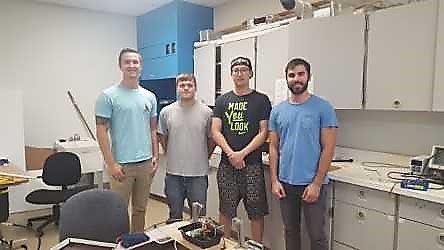 Team Members: Michael Docis – Group Leader; Jonathan Hendrzak – Technical Liaison; Alex Creeger
– Purchasing Agent; Feijie Chen – Communications Specialist
Team Members: Michael Docis – Group Leader; Jonathan Hendrzak – Technical Liaison; Alex Creeger
– Purchasing Agent; Feijie Chen – Communications Specialist
Faculty Advisor: Dr. Brian Trease; Client Advisor: Dr. Adam Schroeder; Project Sponsor: University of Toledo’s Mechanism, Mobility, Multifunctional Design Laboratory (3MDL)
Special Thanks: Dr. Adam Schroeder, for his enthusiastic support and for his tremendous assistance with the program; Dr. Brian Trease, for his continued support and bountiful ideas; 3MDL personnel, especially Terry Schulin and Lauren Marshall
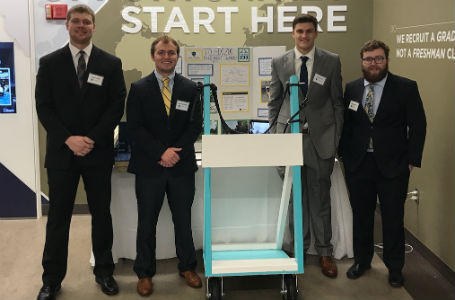 Our project was to create some sort of launcher for the Toledo Zoo for them to launch
enrichment items such as food and toys into the enclosures to try and get the animals
more active. Originally, we thought it was just for the cheetah’s but once we got
to the zoo we found out it was for multiple animals such as the wolves, gorillas,
and all the animals in the safari enclosure. Our client gave us some requirements
that it needed to meet. It needed to be mobile, light and adjustable so that the zoo
employees can move it easily to the different enclosures. We were told that it can’t
be compressed air as it could scare the animals. Our project had an initial design
which involved springs which didn’t work out because it didn’t launch items far enough
and it was way too heavy for what the zoo wanted. The second design was a slingshot
design that was made of wood and had wheels on it to make it transportable. This ended
up working very well and met all the requirements.
Our project was to create some sort of launcher for the Toledo Zoo for them to launch
enrichment items such as food and toys into the enclosures to try and get the animals
more active. Originally, we thought it was just for the cheetah’s but once we got
to the zoo we found out it was for multiple animals such as the wolves, gorillas,
and all the animals in the safari enclosure. Our client gave us some requirements
that it needed to meet. It needed to be mobile, light and adjustable so that the zoo
employees can move it easily to the different enclosures. We were told that it can’t
be compressed air as it could scare the animals. Our project had an initial design
which involved springs which didn’t work out because it didn’t launch items far enough
and it was way too heavy for what the zoo wanted. The second design was a slingshot
design that was made of wood and had wheels on it to make it transportable. This ended
up working very well and met all the requirements.
Team Members: Group Leader – Derich Weiland; Technical Liaison – Joseph Leitch; Purchasing Agent – Carl Herron; Webpage Specialist – Toby Lawton
Faculty Advisor: Dr. Sorin Cioc; Client Advisor: Beth Posta; Project Sponsor: Toledo Zoo
Special Thanks: Beth Posta, Toledo Zoo – For access to the zoo and being our contact; Bill Weiland, Derich’s father – Access to farm with tools, material, and initial testing place; Dr. Cioc, University of Toledo – Main source of guidance
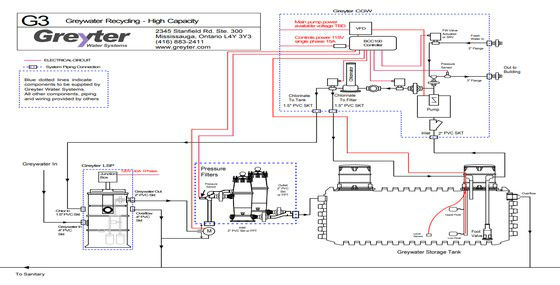 Our group was tasked with determining if a greywater filtration system is viable for
Parks Tower. A greywater filtration system could help the university become more environmentally
friendly as well possibly provide a large cost savings. After research, we determined
it will be possible to collect and filter all shower water and pump the filtered water
back into Parks Tower to supply the toilets. Our group found 4 other systems that
could use any excess filtered water, these are: redirecting water to the river, using
it in cooling towers on campus, using it in the boiler system, or divert it to city
sewage. A cost analysis was performed for all 4 methods and ROI was calculated, with
the best being 40 years. The group concluded a greywater system would best be installed
in any new structure to be built on campus, not a standing structure like Parks Tower.
This project will be passed on to next semester where they may determine if there
is a viable way to implement any of these designs or come up with new designs.
Our group was tasked with determining if a greywater filtration system is viable for
Parks Tower. A greywater filtration system could help the university become more environmentally
friendly as well possibly provide a large cost savings. After research, we determined
it will be possible to collect and filter all shower water and pump the filtered water
back into Parks Tower to supply the toilets. Our group found 4 other systems that
could use any excess filtered water, these are: redirecting water to the river, using
it in cooling towers on campus, using it in the boiler system, or divert it to city
sewage. A cost analysis was performed for all 4 methods and ROI was calculated, with
the best being 40 years. The group concluded a greywater system would best be installed
in any new structure to be built on campus, not a standing structure like Parks Tower.
This project will be passed on to next semester where they may determine if there
is a viable way to implement any of these designs or come up with new designs.
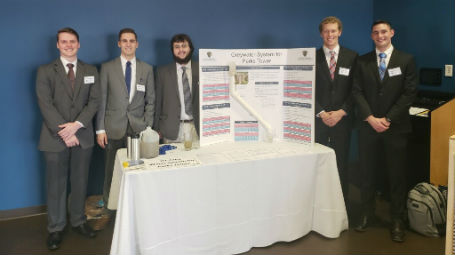 Team Members: Brandon Wolters – Group Leader; Gabe Walters – Technical Liaison; Jonathan Estes
– Purchasing Agent; John Hayes – Web Developer; Keenan Coon – Industrial Engineering
Specialist
Team Members: Brandon Wolters – Group Leader; Gabe Walters – Technical Liaison; Jonathan Estes
– Purchasing Agent; John Hayes – Web Developer; Keenan Coon – Industrial Engineering
Specialist
Faculty Advisor: Dr. Brian Trease; Client Advisor: Michael Green; Project Sponsor: University of Toledo
Special Thanks: Ryan Gierhart from the Ohio EPA (Northwest Region); Lucas County Health Dept.; Greyter Water Systems; Wahaso (Water Harvesting Solutions)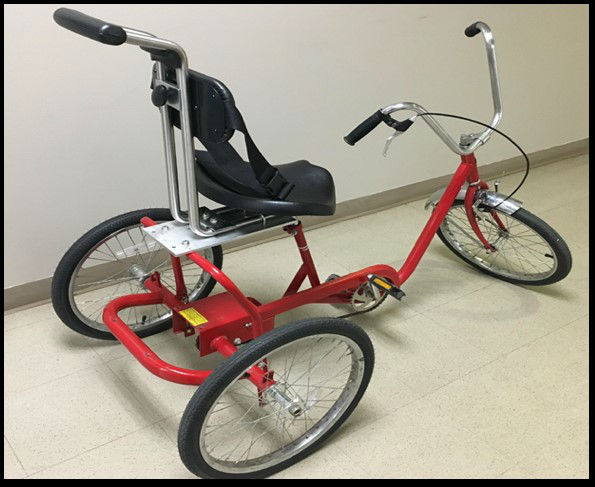 The Toledo Ability Center aims to give the disabled a path to independence. In this
project, their client Willy has autism and cannot currently ride a bike or tricycle
with his family as the result of having balancing deficiencies. Thus, this project
aims to design a stylish and customized tricycle that will keep Willy aesthetic. The
designed tricycle will need to have non-restrictive restraints while still firmly
securing the client. In addition, the tricycle needs to be adjustable to account for
Willy’s growth. The main goal, however, will be to maintain a safe functional tricycle
for Willy, and thus, it will need to sustain a high factor of safety.
The Toledo Ability Center aims to give the disabled a path to independence. In this
project, their client Willy has autism and cannot currently ride a bike or tricycle
with his family as the result of having balancing deficiencies. Thus, this project
aims to design a stylish and customized tricycle that will keep Willy aesthetic. The
designed tricycle will need to have non-restrictive restraints while still firmly
securing the client. In addition, the tricycle needs to be adjustable to account for
Willy’s growth. The main goal, however, will be to maintain a safe functional tricycle
for Willy, and thus, it will need to sustain a high factor of safety.
 Teams Members: Tyler Drees, Jay Nagy, Jeremy Keil, Collin McCabe, Mohammed Alotaibi;
Teams Members: Tyler Drees, Jay Nagy, Jeremy Keil, Collin McCabe, Mohammed Alotaibi;
Faculty Advisor: Dr. Mohamed Samir Hefzy; Client Advisor: Angie Goodnight; Project Sponsor: The Toledo Ability Center
Special Thanks: Wersell’s Bike Shop & Rifton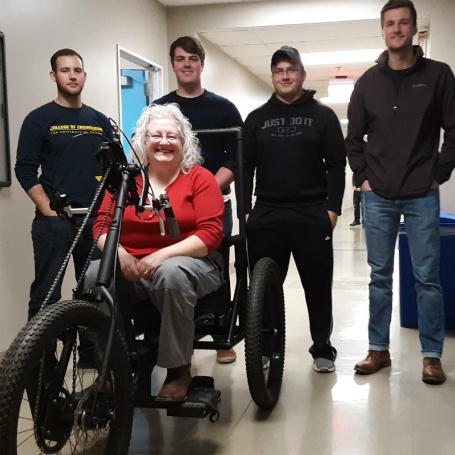 Our client Dolores Guinn is an Army veteran who has lost motor function in her legs
due to illness. She is an avid outdoorsman and hunter who wants to continue to do
what she loves despite not being able to walk. As a result, she has asked for a hand-powered
tricycle that she can use to hunt and ride on in the woods behind her house. To meet
her needs, we met with her throughout the semester to grasp a better idea of what
functions Dolores really needed first, which ranged from multiple gears to forward
and reverse function of the bike.
Our client Dolores Guinn is an Army veteran who has lost motor function in her legs
due to illness. She is an avid outdoorsman and hunter who wants to continue to do
what she loves despite not being able to walk. As a result, she has asked for a hand-powered
tricycle that she can use to hunt and ride on in the woods behind her house. To meet
her needs, we met with her throughout the semester to grasp a better idea of what
functions Dolores really needed first, which ranged from multiple gears to forward
and reverse function of the bike.
By the end of the semester, we produced a working tricycle that moves in forward and reverses through all 3 gears and was built from standard bicycle parts, in order to maintain the simplicity of design and repair. The final test drive included Dolores herself pulling our group leader Bryon on a sled to simulate dragging an animal. The final result was that the tricycle functioned as intended with and without weight added.
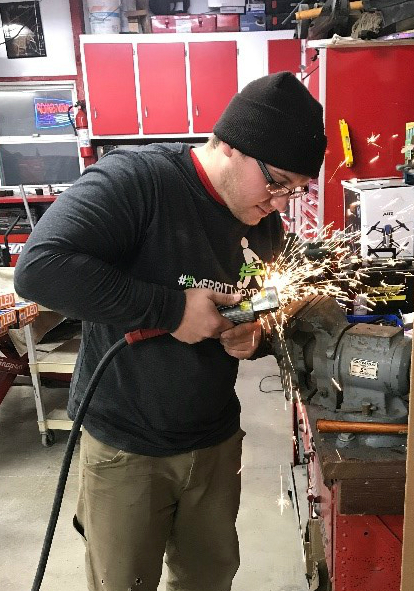 Team Members: Bryon Jordan- Group Leader; Jeffrey Banachowski- Purchasing Agent; Thomas Garner-
Technical Liaison; Dustin Reeder- Communications Contact
Team Members: Bryon Jordan- Group Leader; Jeffrey Banachowski- Purchasing Agent; Thomas Garner-
Technical Liaison; Dustin Reeder- Communications Contact
Faculty Advisor: Dr. Adam Schroeder; Client Advisor: Dolores Guinn; Project Sponsor: Angie Goodnight, Toledo Ability Center
Special Thanks: Garner Precision Collision, Toledo Bikes
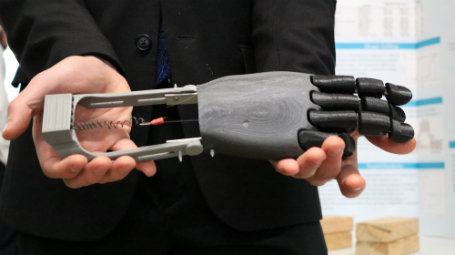 Nitinol is a shape memory alloy made from nickel and titanium. Shape memory alloys
express the ability to “remember” a set shape. When deformed, heat can be applied
to eliminate residual strain left on the material, causing it to return to its “memorized
shape”. This unique property provides the opportunity to convert heat energy into
mechanical energy. Our group applied this concept to a 3D printed prosthetic hand.
Sending electricity through nitinol springs heats up the nitinol and forces it to
contract. The springs pull wires that run through the hand and fingers. This allows
us to manipulate and bend the fingers for effortless movement.
Nitinol is a shape memory alloy made from nickel and titanium. Shape memory alloys
express the ability to “remember” a set shape. When deformed, heat can be applied
to eliminate residual strain left on the material, causing it to return to its “memorized
shape”. This unique property provides the opportunity to convert heat energy into
mechanical energy. Our group applied this concept to a 3D printed prosthetic hand.
Sending electricity through nitinol springs heats up the nitinol and forces it to
contract. The springs pull wires that run through the hand and fingers. This allows
us to manipulate and bend the fingers for effortless movement.
 Team Members: Bryce Williams, Marcus Ardner, Nate Durkovic
Team Members: Bryce Williams, Marcus Ardner, Nate Durkovic
Faculty Advisor: Dr. Elahinia; Client Advisor: Mohammadreza Nematollahi; Project Sponsor: Dr. Elahinia
Special Thanks: Maker Society
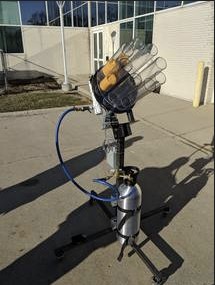 The University of Toledo Athletic Department has a tradition of providing an engaging
and exciting experience for its sports fans. At the beginning of our semester, the
department approached us about designing a device that would further increase the
level of excitement for fans.
The University of Toledo Athletic Department has a tradition of providing an engaging
and exciting experience for its sports fans. At the beginning of our semester, the
department approached us about designing a device that would further increase the
level of excitement for fans.
Currently, the University uses two carbon dioxide powered t-shirt cannons to launch shirts during timeouts and stoppages of play. These cannons work but are relatively unreliable and the Athletic Department thought that we could design something more reliable that would also make the experience more exciting. After discussing the idea with our team, we decided that a Gatling style cannon that sequentially launched shirts out of multiple barrels would be the answer.
After 4 months of work, we are proud to present the Athletic department with our solution, and hope they will be able to use it to help create an even better environment for the University’s sports fans.
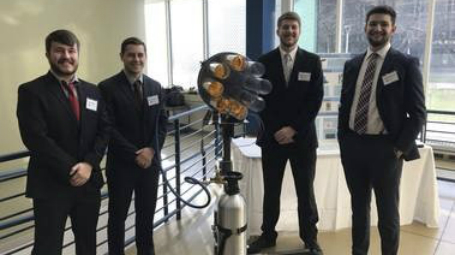 Team Members: Ryan O’Callaghan, Richard Gobrecht, Evan Hartenburg, Tyler Sullivan
Team Members: Ryan O’Callaghan, Richard Gobrecht, Evan Hartenburg, Tyler Sullivan
Faculty Advisor: Dr. Sorin Cioc; Client Advisor: Adam Simpson; Project Sponsor: UT Athletic Department
Special Thanks: John Jaegly, Tim Grivanos, and the Entire M.I.M.E. Machine Shop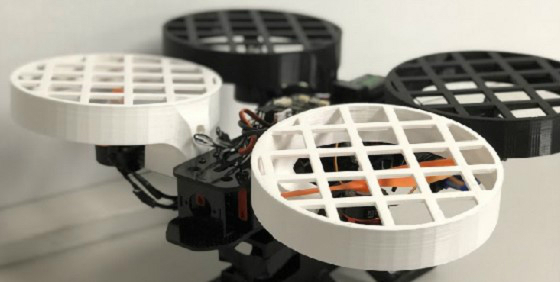 Our group was tasked with creating a UT Athletics equivalent of the Toledo Walleye
‘Super Spike’ RC drone powered blimp. UT Athletics is currently looking at options
to increase crowd engagement during stoppages of play. A remote-controlled blimp,
similar to ‘Super Spike’, could be used to drop prizes on the fans at Toledo sports
games. By designing the drone portion of this project, we have been able to complete
a custom built which includes the blimp controlling capabilities as well as a prize
drop mechanism. Because of its modularity, it will be possible to add additional features
as desired in the future.
Our group was tasked with creating a UT Athletics equivalent of the Toledo Walleye
‘Super Spike’ RC drone powered blimp. UT Athletics is currently looking at options
to increase crowd engagement during stoppages of play. A remote-controlled blimp,
similar to ‘Super Spike’, could be used to drop prizes on the fans at Toledo sports
games. By designing the drone portion of this project, we have been able to complete
a custom built which includes the blimp controlling capabilities as well as a prize
drop mechanism. Because of its modularity, it will be possible to add additional features
as desired in the future.
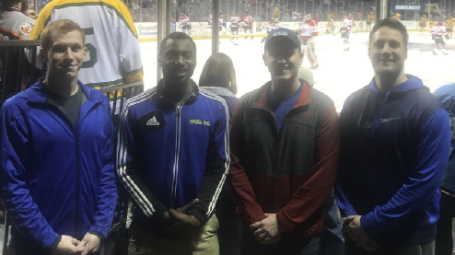 Team Members: Scott Brittenham, Richard Gahutu, Michael Kranz, and Thomas Walbom
Team Members: Scott Brittenham, Richard Gahutu, Michael Kranz, and Thomas Walbom
Faculty Advisor: Dr. Robert Langenderfer
Client Advisor: Mr. Adam Simpson
Project Sponsor: University of Toledo Athletics Department
Special Thanks: The Toledo Walleye and Huntington Center
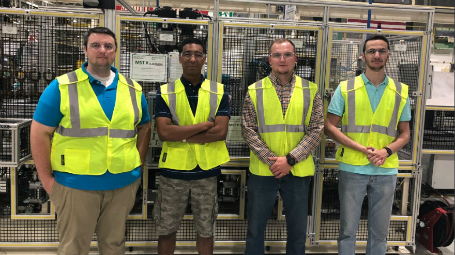 The objective of this senior design project is to identify and improve upon processes
that are hindering the speed and reliability of the World Gas Engine and Tigershark
4-cylinder engine line at the Fiat-Chrysler Engine Plant in Dundee, Michigan. Our
client and his co-workers have decided there is a bottleneck in the system, but have
yet to come to a conclusion as to what the main issue is. They have brought our team
in to have a fresh set of eyes on the issues and provide on the ground support. FCA
wanted us to proceed with Option 2: Finding a motor, gearbox and other components
that would be able to increase the speed of the conveyor system. After extensive research
and contacting the suppliers, we found a system that would improve the speed by 6
m/min without hindering the performance of the line. After conducting multiple time trials, we
decided that we needed to implement a faster motor and gearbox combination than what
was suggested to get us up to 18m/min. Upgrading to this system will improve overall
travel time by 15 seconds. This will also require additional add-ons of heavy duty
stop gates. This is so the stop gates can handle the load of an entire queue full
of pallets. This would save approximately $3.2 million per year considering the production
line runs 40 hours per week.
The objective of this senior design project is to identify and improve upon processes
that are hindering the speed and reliability of the World Gas Engine and Tigershark
4-cylinder engine line at the Fiat-Chrysler Engine Plant in Dundee, Michigan. Our
client and his co-workers have decided there is a bottleneck in the system, but have
yet to come to a conclusion as to what the main issue is. They have brought our team
in to have a fresh set of eyes on the issues and provide on the ground support. FCA
wanted us to proceed with Option 2: Finding a motor, gearbox and other components
that would be able to increase the speed of the conveyor system. After extensive research
and contacting the suppliers, we found a system that would improve the speed by 6
m/min without hindering the performance of the line. After conducting multiple time trials, we
decided that we needed to implement a faster motor and gearbox combination than what
was suggested to get us up to 18m/min. Upgrading to this system will improve overall
travel time by 15 seconds. This will also require additional add-ons of heavy duty
stop gates. This is so the stop gates can handle the load of an entire queue full
of pallets. This would save approximately $3.2 million per year considering the production
line runs 40 hours per week.
Team Members: Abdel Hakim Abou Yassine, Brendan Bennekamper, John Heninger, and Benjamin Nadarajah
Faculty Advisor: Dr. Franchetti; Client Advisor: John Montri; Project Sponsor: FCA Dundee Engine Plant
Special Thanks: Dr. Trease, Dr. Franchetti, and FCA Dundee Engine Plant.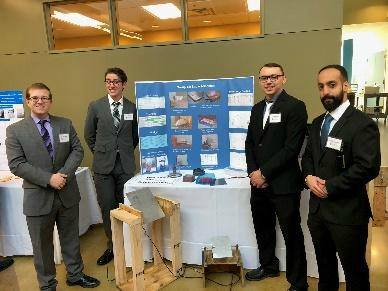 For this leg of a multi-part project, the design team's objective is to design an
experiment to test adhesion of snow to aluminum at differing Liquid Water Contents
and test each of the experiments to gather data points. A secondary goal is to design
a way to test snow adhesion on different materials. Moving forward the data gathered
from various testing can help us understand and quantify how snow adheres to different
materials with the ultimate goal of designing a way to passively remove snow from
cable stay bridges, smart car camera lenses, and the sides of ships sailing through
cold waters.
For this leg of a multi-part project, the design team's objective is to design an
experiment to test adhesion of snow to aluminum at differing Liquid Water Contents
and test each of the experiments to gather data points. A secondary goal is to design
a way to test snow adhesion on different materials. Moving forward the data gathered
from various testing can help us understand and quantify how snow adheres to different
materials with the ultimate goal of designing a way to passively remove snow from
cable stay bridges, smart car camera lenses, and the sides of ships sailing through
cold waters.
Team Members: Kyle Stallings, Jesse Haefka, Khaled Alresayes and Joel McVicker Jr.
Faculty Advisor: Dr. Hossein Sojoudi and Dr. Douglas Nims
Client Advisor: Dr. Hossein Sojoudi and Dr. Douglas Nims
Special Thanks: Dr. Sojoudi, Dr. Nims, Jamie Heil, Mehdi Sarayloo, Behrouz Mohammadian, Mr. Jaegly
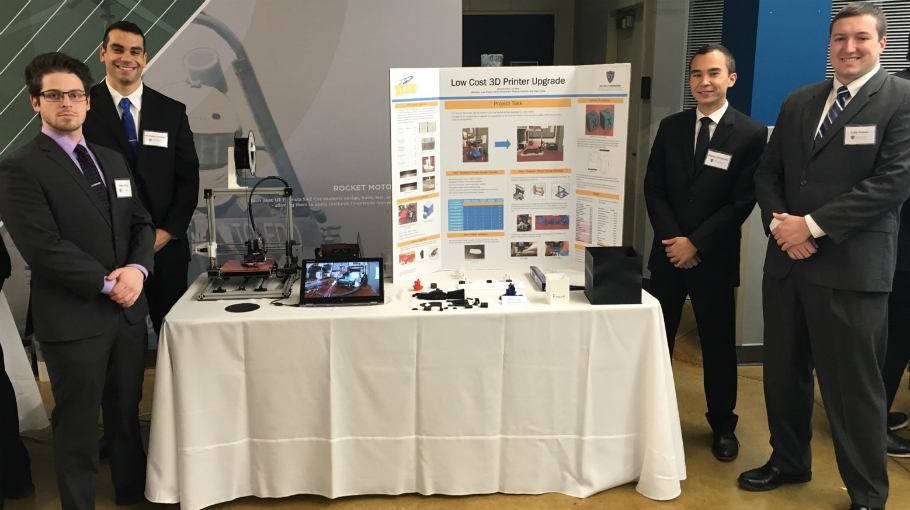 The OneUp 3D printer was released in 2013 as the first 3D printer available for under
$200. Dr. Rizvi purchased this printer from Kickstarter but did not manage to get
it working. The printer was made of low-quality materials, such as MDF board and zip
ties, and also used a very outdated slicer. After a senior design group got the OneUp
to print at a low quality, this team was tasked with upgrading the printer in terms
of print quality, build volume, and material compatibility. A new board was installed
on the OneUp and after using a new slicer and updated firmware, the OneUp was printing
better than before. With Dr. Rizvi’s guidance, the decision was made to build a brand-new
printer with parts designed by this group. The new printer named “Theseus” was, an
upgrade in virtually every aspect when compared to the OneUp. The new frame, gantry,
additional z-screw, build plate, print head, hot end, and cooling system all increased
the printer’s quality. After testing the Theseus printer, the print quality was much
better than the OneUp and was even comparable with more expensive printers such as
Makerbots and Ultimakers.
The OneUp 3D printer was released in 2013 as the first 3D printer available for under
$200. Dr. Rizvi purchased this printer from Kickstarter but did not manage to get
it working. The printer was made of low-quality materials, such as MDF board and zip
ties, and also used a very outdated slicer. After a senior design group got the OneUp
to print at a low quality, this team was tasked with upgrading the printer in terms
of print quality, build volume, and material compatibility. A new board was installed
on the OneUp and after using a new slicer and updated firmware, the OneUp was printing
better than before. With Dr. Rizvi’s guidance, the decision was made to build a brand-new
printer with parts designed by this group. The new printer named “Theseus” was, an
upgrade in virtually every aspect when compared to the OneUp. The new frame, gantry,
additional z-screw, build plate, print head, hot end, and cooling system all increased
the printer’s quality. After testing the Theseus printer, the print quality was much
better than the OneUp and was even comparable with more expensive printers such as
Makerbots and Ultimakers.
Team Members: Luke Poston Team Leader; Patrick Shemenski, Technical Liaison; Anthony Coustillac, Purchasing Agent; Dejan Orsag Web Page Specialist
Faculty Advisor and Client Advisor: Dr. Reza Rizvi
Special Thanks to the UT Makers Society
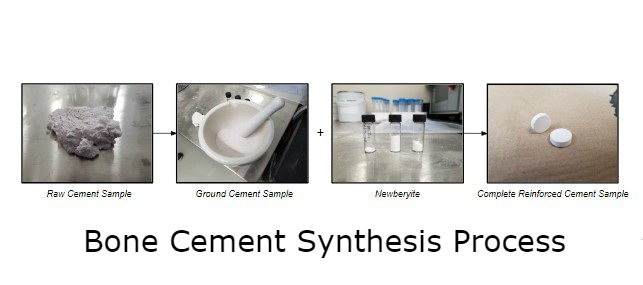 Bone cement is used in many different surgical situations ranging from dental surgery
to spinal surgery. The current types of bone cement behave like ceramic with low
elastic strength. Because of the low elastic strength, developers desire as high
of compression and tensile strength as possible. The objective of this project is
to improve the compressive strength and the injectability of our client, Dr. Bhaduri’s,
FDA approved Orthopaedic Medical Cement. This bone cement is used in bone fractures
to minimize the hospital time, speed up recovery, and causes less pain to the patient
when applied correctly. The bone cement is completely biodegradable and biocompatible,
which is an important parameter that the project team had to consider when formulating
potential design solutions to increase the injectability and compressive strength.
This bone cement an also be utilized for dental applications and small bone fractures,
thus making it a viable solution for many orthopedic applications performed every
day. The compressive strength of the material needs to be improved, along with the
injectability properties. Throughout this report, the project team developed potential
solutions to each of these main objectives, and then testing procedures were also
determined. A final conclusion and a path forward was developed at the end of the
report.
Bone cement is used in many different surgical situations ranging from dental surgery
to spinal surgery. The current types of bone cement behave like ceramic with low
elastic strength. Because of the low elastic strength, developers desire as high
of compression and tensile strength as possible. The objective of this project is
to improve the compressive strength and the injectability of our client, Dr. Bhaduri’s,
FDA approved Orthopaedic Medical Cement. This bone cement is used in bone fractures
to minimize the hospital time, speed up recovery, and causes less pain to the patient
when applied correctly. The bone cement is completely biodegradable and biocompatible,
which is an important parameter that the project team had to consider when formulating
potential design solutions to increase the injectability and compressive strength.
This bone cement an also be utilized for dental applications and small bone fractures,
thus making it a viable solution for many orthopedic applications performed every
day. The compressive strength of the material needs to be improved, along with the
injectability properties. Throughout this report, the project team developed potential
solutions to each of these main objectives, and then testing procedures were also
determined. A final conclusion and a path forward was developed at the end of the
report.
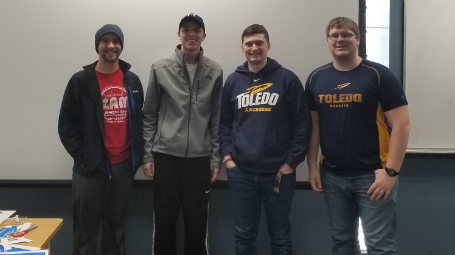 Team Members: Jacob Ritchart, Ryan Kahle, Seth Bell, Brent Biernacki
Team Members: Jacob Ritchart, Ryan Kahle, Seth Bell, Brent Biernacki
Faculty Advisor and Client Advisor: Dr. Sarit Bhaduri
Project Sponsor: National Science Foundation
Special Thanks: Terry Schulin
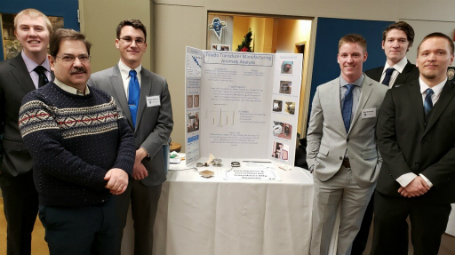 Load cell manufacturer Toledo Transducer is experiencing a high reject rate of 30%
for one specific model of transducers due to sensor linearity errors. Manufacturing
of the load cell after machining is believed to be the root of these failures, specifically
grit blasting. Our group’s project was to find the root cause of the linearity errors
and then try to propose a solution to it. All the while documenting our findings.
Sample parts were obtained and measured in a blind test using the university’s coordinate
measuring machine as well as pressure indicating film. We achieved a solution after
doing various measurement and calibration tests to sample parts pre- and post- grit
blasting and came to a definitive solution to the problem.
Load cell manufacturer Toledo Transducer is experiencing a high reject rate of 30%
for one specific model of transducers due to sensor linearity errors. Manufacturing
of the load cell after machining is believed to be the root of these failures, specifically
grit blasting. Our group’s project was to find the root cause of the linearity errors
and then try to propose a solution to it. All the while documenting our findings.
Sample parts were obtained and measured in a blind test using the university’s coordinate
measuring machine as well as pressure indicating film. We achieved a solution after
doing various measurement and calibration tests to sample parts pre- and post- grit
blasting and came to a definitive solution to the problem.
Team Members: Kyle Breymaier - Communications Specialist; Scot Lamparter - Assistant to the Technical Liaison; Timothy Reed - Group Leader; Chip Rowe - Purchasing Agent; Austin Warchol - Technical Liaison
Faculty Advisor: Dr. John Jaegly; Client Advisor: Brad Mettert; Project Sponsor: Toledo Transducer
Special Thanks: Special thanks to John Jaegly, and Brad Mettert for all the help they gave
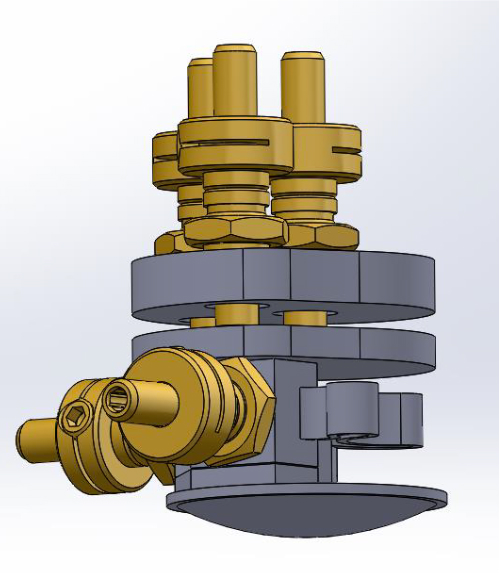 The goal for our project is to design a high precision mirror mount to help align
a secondary mirror on optical communications satellites for NASA Glenn Research Center.
The mechanism will need to have five degrees of freedom and use precision calibration
for permanent alignment of the mirror. The cross-sectional area of the mechanism must
as small as possible so that there is minimal blockage of the signal. NASA is researching
the use of optical communications because it allows data to be transferred up to 10
times faster than with radio waves. Optical communication is projected to be the future
of data transmission in space applications.
The goal for our project is to design a high precision mirror mount to help align
a secondary mirror on optical communications satellites for NASA Glenn Research Center.
The mechanism will need to have five degrees of freedom and use precision calibration
for permanent alignment of the mirror. The cross-sectional area of the mechanism must
as small as possible so that there is minimal blockage of the signal. NASA is researching
the use of optical communications because it allows data to be transferred up to 10
times faster than with radio waves. Optical communication is projected to be the future
of data transmission in space applications.
 Team Members: Tyler Smith, Ciaran Duffy, Nick Pasquale, Michael McQuillen
Team Members: Tyler Smith, Ciaran Duffy, Nick Pasquale, Michael McQuillen
Faculty Advisor: Dr. Brian Trease
Client Advisor: Kelly McEntire
Project Sponsor: NASA Glenn Research Center


